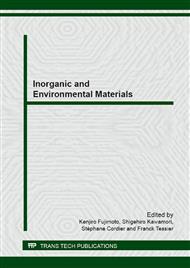p.24
p.28
p.32
p.36
p.40
p.46
p.50
p.61
p.68
Removal of Toxic Oxyanion from Aqueous Solution Using Calcium Alumino-Zincate
Abstract:
Various problems related to pollution of soil and groundwater caused by toxic oxyanion have been actualized in recent years. In particular, the enlargement of the polluted area by diffusion of chromate ions has been a worry in Japan, and arsenic pollution of well water is also a serious problem in South Asia nations. Removal process of chromate and arsenic in aqueous solution using 14CaO·5Al2O3·6ZnO, which is an easy-to-use method technically, has been investigated in our laboratory. The results obtained are summarized as follows: 1) Oxyanion of chromium and arsenic such as CrO42-, AsO33- and AsO43- ions are able to be removed from aqueous solution by addition of 14CaO·5Al2O3·6ZnO, however, the removal rate of those arsenic ions are much lower than that of CrO42-. 2) Removal of CrO42- from aqueous solution is caused by the immobilization to 3CaO·Al2O3·CaCrO4·12H2O, on the other hand, both AsO33- and AsO43- mainly occurred by the adsorption to unhydrated 14CaO·5Al2O3·6ZnO. 3) Simultaneous use of 14CaO·5Al2O3·6ZnO and calcium hydroxide is an effective method in the removal of CrO42-, AsO33- and AsO43- from aqueous solution.
Info:
Periodical:
Pages:
40-45
Citation:
Online since:
June 2014
Authors:
Keywords:
Price:
Сopyright:
© 2014 Trans Tech Publications Ltd. All Rights Reserved
Share:
Citation:


